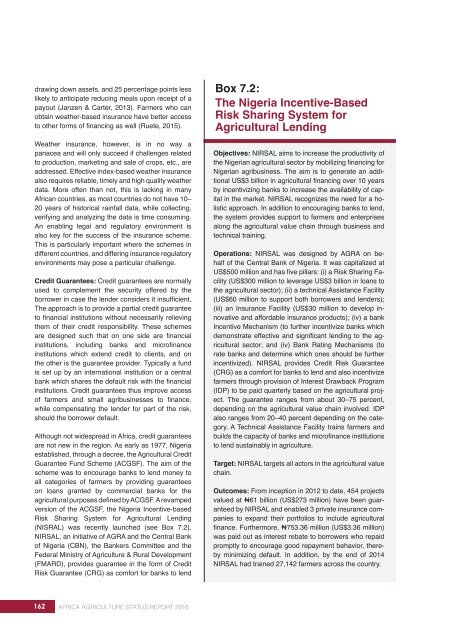AFRICA AGRICULTURE STATUS REPORT 2016
AASR-report_2016-1
AASR-report_2016-1
You also want an ePaper? Increase the reach of your titles
YUMPU automatically turns print PDFs into web optimized ePapers that Google loves.
drawing down assets, and 25 percentage points less<br />
likely to anticipate reducing meals upon receipt of a<br />
payout (Janzen & Carter, 2013). Farmers who can<br />
obtain weather-based insurance have better access<br />
to other forms of financing as well (Ruete, 2015).<br />
Weather insurance, however, is in no way a<br />
panacea and will only succeed if challenges related<br />
to production, marketing and sale of crops, etc., are<br />
addressed. Effective index-based weather insurance<br />
also requires reliable, timely and high quality weather<br />
data. More often than not, this is lacking in many<br />
African countries, as most countries do not have 10–<br />
20 years of historical rainfall data, while collecting,<br />
verifying and analyzing the data is time consuming.<br />
An enabling legal and regulatory environment is<br />
also key for the success of the insurance scheme.<br />
This is particularly important where the schemes in<br />
different countries, and differing insurance regulatory<br />
environments may pose a particular challenge.<br />
Credit Guarantees: Credit guarantees are normally<br />
used to complement the security offered by the<br />
borrower in case the lender considers it insufficient.<br />
The approach is to provide a partial credit guarantee<br />
to financial institutions without necessarily relieving<br />
them of their credit responsibility. These schemes<br />
are designed such that on one side are financial<br />
institutions, including banks and microfinance<br />
institutions which extend credit to clients, and on<br />
the other is the guarantee provider. Typically a fund<br />
is set up by an international institution or a central<br />
bank which shares the default risk with the financial<br />
institutions. Credit guarantees thus improve access<br />
of farmers and small agribusinesses to finance,<br />
while compensating the lender for part of the risk,<br />
should the borrower default.<br />
Although not widespread in Africa, credit guarantees<br />
are not new in the region. As early as 1977, Nigeria<br />
established, through a decree, the Agricultural Credit<br />
Guarantee Fund Scheme (ACGSF). The aim of the<br />
scheme was to encourage banks to lend money to<br />
all categories of farmers by providing guarantees<br />
on loans granted by commercial banks for the<br />
agricultural purposes defined by ACGSF. A revamped<br />
version of the ACGSF, the Nigeria Incentive-based<br />
Risk Sharing System for Agricultural Lending<br />
(NISRAL) was recently launched (see Box 7.2).<br />
NIRSAL, an initiative of AGRA and the Central Bank<br />
of Nigeria (CBN), the Bankers Committee and the<br />
Federal Ministry of Agriculture & Rural Development<br />
(FMARD), provides guarantee in the form of Credit<br />
Risk Guarantee (CRG) as comfort for banks to lend<br />
Box 7.2:<br />
The Nigeria Incentive-Based<br />
Risk Sharing System for<br />
Agricultural Lending<br />
Objectives: NIRSAL aims to increase the productivity of<br />
the Nigerian agricultural sector by mobilizing financing for<br />
Nigerian agribusiness. The aim is to generate an additional<br />
US$3 billion in agricultural financing over 10 years<br />
by incentivizing banks to increase the availability of capital<br />
in the market. NIRSAL recognizes the need for a holistic<br />
approach. In addition to encouraging banks to lend,<br />
the system provides support to farmers and enterprises<br />
along the agricultural value chain through business and<br />
technical training.<br />
Operations: NIRSAL was designed by AGRA on behalf<br />
of the Central Bank of Nigeria. It was capitalized at<br />
US$500 million and has five pillars: (i) a Risk Sharing Facility<br />
(US$300 million to leverage US$3 billion in loans to<br />
the agricultural sector); (ii) a technical Assistance Facility<br />
(US$60 million to support both borrowers and lenders);<br />
(iii) an Insurance Facility (US$30 million to develop innovative<br />
and affordable insurance products); (iv) a bank<br />
Incentive Mechanism (to further incentivize banks which<br />
demonstrate effective and significant lending to the agricultural<br />
sector; and (iv) Bank Rating Mechanisms (to<br />
rate banks and determine which ones should be further<br />
incentivized). NIRSAL provides Credit Risk Guarantee<br />
(CRG) as a comfort for banks to lend and also incentivize<br />
farmers through provision of Interest Drawback Program<br />
(IDP) to be paid quarterly based on the agricultural project.<br />
The guarantee ranges from about 30–75 percent,<br />
depending on the agricultural value chain involved. IDP<br />
also ranges from 20–40 percent depending on the category.<br />
A Technical Assistance Facility trains farmers and<br />
builds the capacity of banks and microfinance institutions<br />
to lend sustainably in agriculture.<br />
Target: NIRSAL targets all actors in the agricultural value<br />
chain.<br />
Outcomes: From inception in 2012 to date, 454 projects<br />
valued at ₦61 billion (US$273 million) have been guaranteed<br />
by NIRSAL and enabled 3 private insurance companies<br />
to expand their portfolios to include agricultural<br />
finance. Furthermore, ₦753.36 million (US$3.36 million)<br />
was paid out as interest rebate to borrowers who repaid<br />
promptly to encourage good repayment behavior, thereby<br />
minimizing default. In addition, by the end of 2014<br />
NIRSAL had trained 27,142 farmers across the country.<br />
162 <strong>AFRICA</strong> <strong>AGRICULTURE</strong> <strong>STATUS</strong> <strong>REPORT</strong> <strong>2016</strong>


